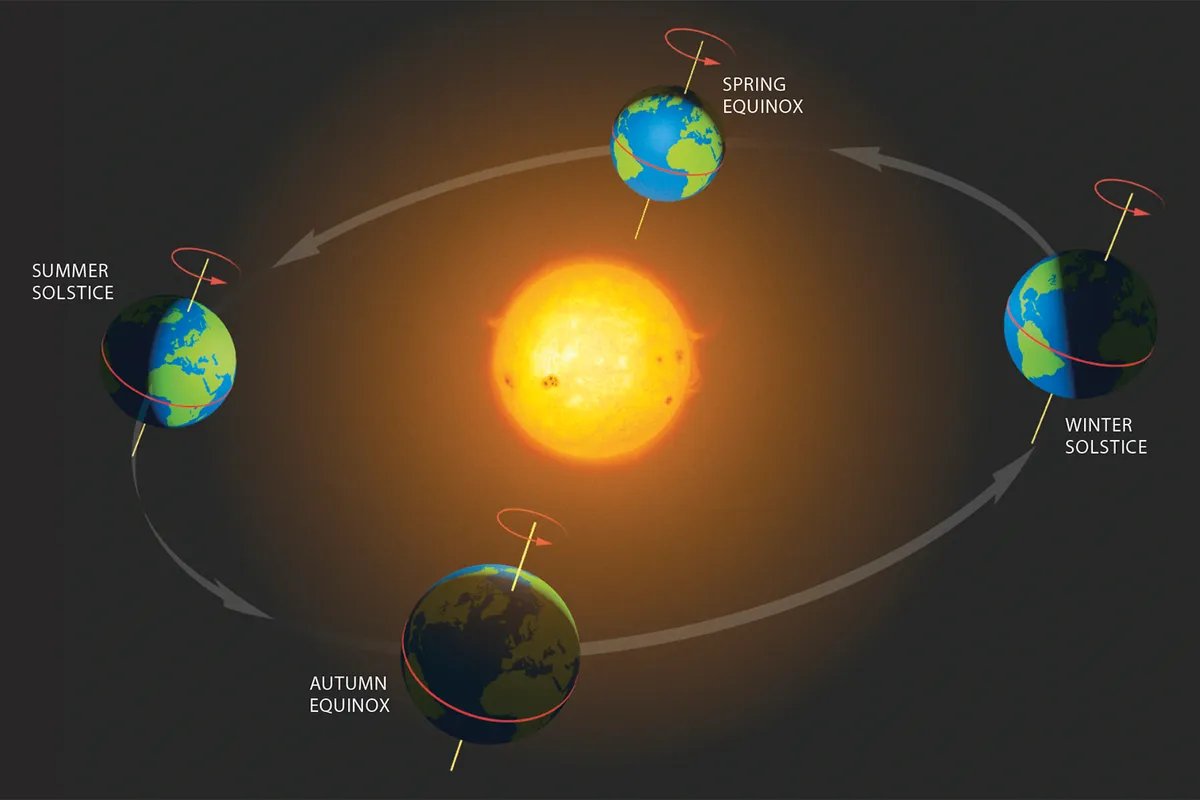In New York City, the gridiron layout of streets means that four times each year, people gather to watch the Sun ‘kiss the grid’, in what’s known as Manhattanhenge or the Manhattan Solstice.
Manhattanhenge – in tribute to England’s neolithic monument Stonehenge – describes four days when either the setting Sun or the rising Sun is aligned with the streets that run east to west in Manhattan.
During each one of these events, onlookers stand in the middle of any of the numbered east-to-west streets on the grid and witness – by looking east (for a sunrise) or west (for a sunset) – the Sun sitting on the horizon between the borough’s famous skyscrapers.

Equinoxes, solstices and the Sun
Exactly where the Sun sets and rises changes constantly throughout the year.
At each equinox, in March and September, the Sun rises due east and sets due west across the world.
In the Northern Hemisphere, after March’s equinox, the Sun appears to rise in the northeast and set in the northwest.
This culminates at the June solstice, when it appears to stop (solstice means ‘Sun standstill’) before moving back to rise due east and set due west at the September equinox.
The Sun then appears to rise and set further south, with the December solstice marking the furthest southeast sunrise and southwest sunset.
Why Manhattanhenge happens
When the pattern of solstices is imposed on Manhattan’s gridiron street layout, it produces a Manhattanhenge effect.
If the borough’s streets were aligned perfectly with the cardinal points, Manhattanhenge would take place on the equinoxes.
However, that’s not the case, because the gridiron is aligned 29˚ clockwise from true east–west.
In practice, that produces two groups of two days, each 22/23 days on either side of the date of the June solstice, when the Sun sets 29˚ north of due west (being 270˚).
That precise azimuth means that the Sun must set on the grid of Manhattan.

Best days and times for Manhattanhenge 2024
You should always take care when observing the Sun.
The most impactful view of Manhattanhenge is when half of the Sun’s disc is visible on the grid at sunset, because you get to see the Sun ‘kiss the grid’.
In 2024, those dates and times are Tuesday 28 May at 8:13pm EDT and Saturday 13 July at 8:21pm EDT.
These ‘kiss the grid’ evenings both come with a bonus evening, when you can see the entire Sun’s disc sit on the grid just before the moment of sunset begins.
In 2024, these ‘full Sun’ dates will be Wednesday 29 May at 8:12pm EDT (the day after the first ‘kiss the grid’ sunset) and Friday 12 July at 8:20pm EDT (the day before the second ‘kiss the grid’ sunset).
Manhattanhenge at sunrise
These are the headline acts, the attention-grabbing moments that the media reports and that people will travel to see.
The Manhattanhenge effect also works at sunrise, but since 5 December and 8 January – either side of the December solstice – are generally bitterly cold and cloudy in Manhattan, few are in a position to watch the rising Sun sit on the grid.

Other famous city henges
Other examples of similar alignments include Chicagohenge (on the dates of the equinoxes), Torontohenge (16 February and 25 October) and even Milton Keynes-henge (where the main street
frames the rising Sun on the June solstice).
What makes Manhattan the standout is the clear horizon beyond its grid, thanks to the Hudson River.
Although the ‘kiss the grid’ sunsets get all the attention, for those with a keen astronomical eye,
the Manhattanhenge effect extends from the first event on 28 May to the last on 13 July, when the
Sun can be seen crossing the grid as it sets each evening.
It means 46 evenings of fabulous sunsets, clear skies allowing.

Best places to see Manhattanhenge
The best views looking west at sunset are in the eastern half of Manhattan, above 14th Street and below 155th Street, with prime spots including 14th, 23rd, 34th, 42nd and 57th Streets.
The most popular places to watch Manhattanhenge include the junction of 14th Street and Third Avenue, Tudor City Bridge and Central Park’s Great Lawn.
If you want a good spot, it pays to get there early, at least a few hours before sunset.
Seven of the best places to view Manhattanhenge are:
- E 14th Street and Third Avenue
- E 23rd Street and Fifth Avenue or Broadway
- W 34th Street and Fifth Avenue
- Tudor City Bridge, E 42nd Street
- W 57th Street and Eighth Avenue
- Great Lawn, Central Park
- W 79th Street and Columbus
You can see these spots in our map below.

How to photograph Manhattanhenge
A clear sky is the key to photographing a Manhattanhenge sunset.
Clouds will completely kill this spectacle, so check weather forecasts.
You can get a good shot with any camera or smartphone, but you can take both close-ups and wide angles if you use a camera with a zoom lens.

Never look through the viewfinder when photographing a sunset – only look at the image on the camera’s rear screen.
You’ll need to stand in the middle of the street, so care is of course needed.
Have you seen or photographed Manhattanhenge? Share your experiences and images with us via contactus@skyatnightmagazine.com.
This article appeared in the June 2023 issue of BBC Sky at Night Magazine
